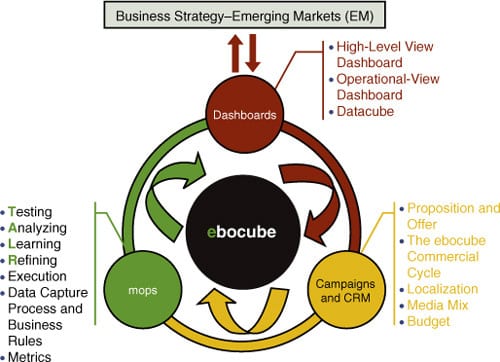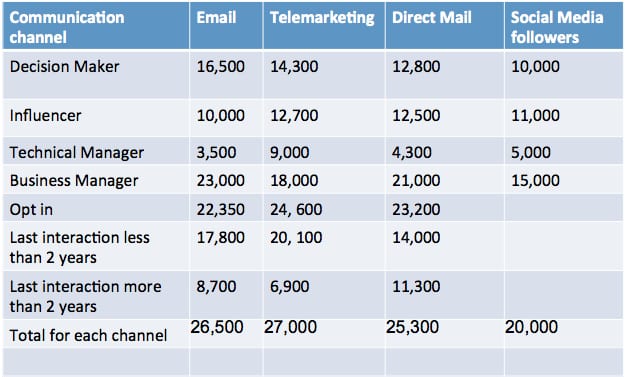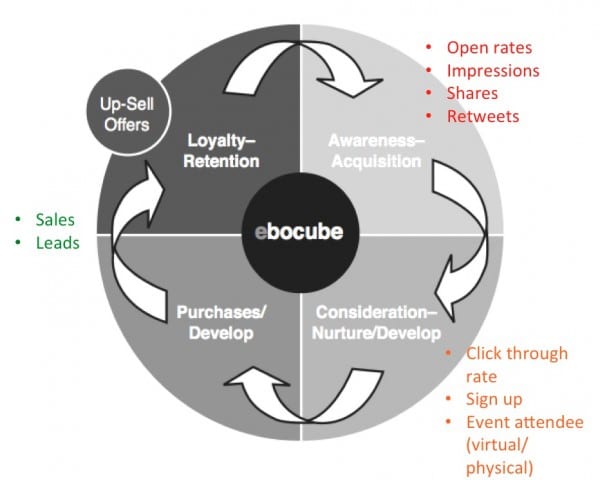Applying the Ebocube B2B Digital Marketing model for international market development
Emerging markets are countries experiencing relatively recent industrial, political and technological change resulting in rapid economic growth. Emerging markets cover more than the BRICs (Brazil, Russia, India, China, South Africa), however; these countries are amongst the buoyant emerging giants.
Large populations generally characterise these markets, as is obvious with China and India. They tend to be dominated by young populations and rising middle classes.
As business revenues plateau in saturated, developed markets, expansion into emerging markets is a popular means for reaching new growth targets. Although these countries are affected by the global recession, many remain in robust growth positions. The endeavour of international business involves uncertainty and risk, however; this can be mitigated by the internet .
Bringing the Next Billion People Online
Developed countries have long defined the Internet, however, at least 500 million new users of the Internet are expected to come from emerging markets from 2012 to 2015, according to Google. And the cyber-landscape is set to drastically change.
The Internet and social media were instrumental in facilitating the Arab Spring and have brought a new wave of Internet businesses and active users to the region.
China’s current online retail market size is second only to the United States and is predicted to explode over the next five years. (A.T. Kearney Retail e-Commerce Index of Emerging Markets)
How the Global Digital Era and Emerging Market Growth is Transforming the Marketing Agenda
Senior executives in developed economies, working in organizations, small and large, are asking the following questions:
- How can we get ahead of competitors in emerging markets?
- How can our business mitigate risks when we enter risky, high-growth emerging markets?
- How can we measure marketing activities and sales-related results in these markets?
Ebocube B2B digital marketing model
Foreseeing the need for advice on marketing in emerging markets, I applied my knowledge as an International B2B Digital Marketing Manager Lara Fawzy to create an end-to-end B2B Internet marketing model. It's explained in my book Emerging Business Online: Global Markets and the Power of B2B Internet Marketing (FT Press, ISBN 13: 9780137064410, 291).
This robust framework is based on tested processes and results from Cisco, and other multinational experience.
It’s designed to provide a structure for developing B2B electronic customer relationship management (CRM) for global professionals.
It shows marketers how to plan, execute, track, measure and learn from global digital marketing. It demonstrates key marketing metrics in relation to the sales cycle; for the purpose of B2b lead generation and how to measure them.
The model is called ‘ebocube’, which stands for emerging business online, with cube referring to the visual framework of the three-phase model.

The structure is low-cost, and has helped organisations to make significant cost savings and high return on marketing investment (ROMI); it’s a sustainable business-to-business global model, underpinned by the Internet.
Implementing the Ebocube model in three phases:
Phase One: The Dashboard and the Datacube.
This phase focuses on reporting on marketing, sales, and company or contact data for the businesses being targeted in emerging markets. It measures what’s working (or not working) and which market is generating the highest return on marketing investment (ROMI). The datacube also represents the quality of contact data to leverage an eCRM strategy. These reports mean business decisions are not based on instinct or assumption, but on numbers and business intelligence.
Phase Two: Campaign and Data planning.
Using the ebocube commercial cycle (contact buying cycle/decision-making process and data life cycle), phase two discusses the proposition, messaging, the incentive, localization, budgeting, and integrating the media mix (online and offline) to achieve ebocube commercial cycle goals.
Phase Three: Marketing Operations or mops.
Phase three covers budgeting, planning, executing, tracking, and measuring campaigns to feed the dashboard with meaningful metrics. It also demonstrates how to feed your company database, with contact and company data, which can be represented in the datacube. Phase three closes the loop on marketing, data, and sales in global markets.
ebocube model demystifies sales and marketing practices as relationships crisscross digital, business, and national borders.
How it works:
Dashboard:
Firstly, you'll want to review a dashboard of results for previous campaigns, looking at what's worked and what hasn't to decide on your medi mix, target countries and industries.
DataCube:
After choosing your segmentation strategy, you'll need an extract of your campaign data "DataCube", to determine how many people in your target audience can be reached with your campaign.

SMART Campaign and Data planning:
Based on the number of contacts and opt in for your audience, you can determine whether you have the data to proceed or sufficient social media "followers" and plan the campaign using SMART objectives which set the basis for results and metrics. If at this stage, you realise that you do not have sufficient data you may consider acquiring contacts.
Buying cycle + data cycle ebocube = commercial cycle:
The campaign and objectives should be intended to move contacts around the buying cycle.
There are various metrics which can be captured in the Dashboard to inform you about whether or not you're achieving these objectives.
At every stage of the buying cycle you will use a specific set of data or capture data. For example when raising brand awareness for prospects you will acquire new data or more data about them. To up-sell you would target your loyal customer data set.
The traditional buying cycle and data cycle has been combined in this book to create the "ebocube commercial" cycle as data objectives and targeting should be aligned closely with campaign objectives.

Budgeting:
At this stage you should have a set budget for your campaigns. This may be based on what's been allocated and your business priorities, historical cost data which can be stored in marketing operational tools, or marketing resource management tools (MRM) or based on the expected return on marketing investment (ROMI).
Budgeting can be carried out in an online budgeting application, budget data should feed your Dashboard with return on investment metrics broken down per campaign.
Localisation, content, creative, messages and media mix
After these considerations, you will plan localised campaigns and your media mix. Localisation is not translation, it involves ensuring the messaging, proposition, media channels, language and art work are all relevant to the local market.

Marketing Operations or mops
After planning the above you'll reach the final stage of setting up communications for tracking to feed the Dashboard and DataCube. This will involve using priority codes, friendly urls redirecting to a campaign-optimised landing page, data capture forms and tracking codes on various sites to measure conversions for example.
This should all be done in marketing operational tools which should feed the overall marketing dashboard with operational results i.e click through rates, open rates, impressions and high level results i.e. leads generated, conversions and sales. At the end of the campaign you will also have captured or refreshed your database, which can be represented in the DataCube closing the loop on your campaign.
For more information on applying this technique, including a list of campaign metrics for the Ebocube commercial cycle, see Emerging Business Online, Global Markets and the Power of B2b Internet Marketing .








